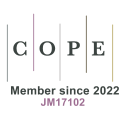REFERENCES
1. Jin J, Chen P, Chen M, Cui Y, Zhang H, Ning S. A bibliometric analysis of the progress of research on natural disaster risk prevention and control based on knowledge graphs. Disaster Sci 2019;2:145-52. (In Chinese).
2. National bureau of statistics of China, China statistical yearbook, China Statistics Press. Available from: https://data.stats.gov.cn/search.htm?s=%E5%9C%B0%E8%B4%A8%E7%81%BE%E5%AE%B3 [Last accessed on 30 Oct 2023].
3. Liu Y, Kong Z, Zhang J. Model construction and analysis of the whole process of disaster emergency management. Disaster Sci 2019;34:198-202. (In Chinese).
4. Central People’s Government of the People’s Republic of China. “Fourteenth five-year plan national comprehensive disaster prevention and mitigation plan”. Available from: https://www.gov.cn/zhengce/zhengceku/2022-07/22/content_5702154.htm [Last accessed on 30 Oct 2023].
5. Pearce L. Disaster management and community planning, and public participation: how to achieve sustainable hazard mitigation. Nat Hazards 2003;28:211-28.
6. Gravina T, Figliozzi E, Mari N, Schinosa FDT. Landslide risk perception in Frosinone (Lazio, Central Italy). Landslides 2017;14:1419-29.
7. Calvello M, Papa MN, Pratschke J, Nacchia Crescenzo M. Landslide risk perception: a case study in Southern Italy. Landslides 2016;13:349-60.
8. Gao X, Roder G, Jiao Y, Ding Y, Liu Z, Tarolli P. Farmers’ landslide risk perceptions and willingness for restoration and conservation of world heritage site of Honghe Hani Rice Terraces, China. Landslides 2020;17:1915-24.
9. Khan G, Qureshi JA, Khan A, et al. The role of sense of place, risk perception, and level of disaster preparedness in disaster vulnerable mountainous areas of Gilgit-Baltistan, Pakistan. Environ Sci Pollut Res Int 2020;27:44342-54.
10. Terpstra T. Flood preparedness: thoughts, feelings and intentions of the Dutch public.
11. Ardaya A, Evers M, Ribbe L. What influences disaster risk perception? Intervention measures, flood and landslide risk perception of the population living in flood risk areas in Rio de Janeiro state, Brazil. Int J Disaster Risk Reduct 2017;25:227-37.
12. Mızrak S, Özdemir A, Aslan R. Adaptation of hurricane risk perception scale to earthquake risk perception and determining the factors affecting women's earthquake risk perception. Nat Hazards 2021;109:2241-59.
13. Adjei E, Benedict BC, Murray-tuite P, Lee S, Ukkusuri S, Ge Y. Effects of risk perception and perceived certainty on evacuate/stay decisions. Int J Disaster Risk Reduct 2022;80:103247.
15. Xu D, Peng L, Liu S, Su C, Wang X, Chen T. Influences of sense of place on farming households’ relocation willingness in areas threatened by geological disasters: evidence from China. Int J Disaster Risk Sci 2017;8:16-32.
16. Xu D, Liu Y, Deng X, et al. Earthquake disaster risk perception process model for rural households: a pilot study from southwestern China. Int J Environ Res Public Health 2019;16:4512.
17. AlQahtany AM, Abubakar IR. Public perception and attitudes to disaster risks in a coastal metropolis of Saudi Arabia. Int J Disaster Risk Reduct 2020;44:101422.
18. Lin Y, Meng J, Wang M. Self-help, shared-help, and public-help: Japan’s disaster emergency management model. China Administration 2022;5:136-43. (In Chinese).
19. Hu S, Yu M, Que T, Fan G, Xing H. Individual willingness to prepare for disasters in a geological hazard risk area: an empirical study based on the protection motivation theory. Nat Hazards 2022;110:2087-111.
20. Li H, Fan C, Jia J, Wang S, Hao L. Public risk perception and emergency management in sudden disasters: the case of the May 12 Wenchuan earthquake. Managing World 2009;6:52-60. (In Chinese) Available from: http://www.doc88.com/p-2069508907679.html [Last accessed on 30 Oct 2023].
21. Li Q, Peng Y, Gu X. Simulation of public emergency response behavior in a sudden disaster situation. In: The 15th Annual China Management Conference. 2020 Nov 6-8; Chengdu, China.
22. Xu J, Lu Y. A comprehensive and integrated model for post-earthquake reconstruction system engineering. Syst Eng Theory Pract 2008;7:1-16. (In Chinese) Available from: http://www.cnki.com.cn/Article/CJFDTotal-XTLL200807001.htm [Last accessed on 30 Oct 2023].
23. Chen B, Li H, Wu Y. A review of the theory of post-Wenchuan earthquake reconstruction. Urban Deve Res 2011;18:105-11. (In Chinese) Available from: http://www.doc88.com/p-7059820915196.html [Last accessed on 30 Oct 2023].
24. Duan Z, Chen T, Yang Q. Behavioral framework and path analysis of public participation in post-disaster infrastructure reconstruction.J Tianjin Uni 2013;15:54-60. (In Chinese) Available from: http://www.cnki.com.cn/Article/CJFDTOTAL-TDXS201301011.htm [Last accessed on 30 Oct 2023]
25. Palm R. Urban earthquake hazards: the impacts of culture on perceived risk and response in the USA and Japan. Appl Geogr 1998;18:35-46.
26. Xu D, Zhou W, Deng X, Ma Z, Yong Z, Qin C. Information credibility, disaster risk perception and evacuation willingness of rural households in China. Nat Hazards 2020;103:2865-82.
27. Zaalberg R, Midden C, Meijnders A, McCalley T. Prevention, adaptation, and threat denial: flooding experiences in the Netherlands. Risk Anal 2009;29:1759-78.
28. Xue K, Guo S, Liu Y, Liu S, Xu D. Social Networks, Trust, and disaster-risk perceptions of rural residents in a multi-disaster environment: evidence from Sichuan, China. Int J Environ Res Public Health 2021;18:2106.
29. Durage SW, Kattan L, Wirasinghe SC, Ruwanpura JY. Evacuation behaviour of households and drivers during a tornado: Analysis based on a stated preference survey in Calgary, Canada. Nat Hazards 2014;71:1495-517.
30. Li H, Fan C, Jia J. Individual behavioral response patterns and influencing factors during earthquake disasters: the case of Lushan earthquake. J Beijing Uni Tech 2017;19:114-20.
31. Bronfman NC, Cisternas PC, Repetto PB, Castañeda JV, Guic E. Understanding the relationship between direct experience and risk perception of natural hazards. Risk Anal 2020;40:2057-70.
32. Xu D, Liu E, Wang X, Tang H, Liu S. Rural households' livelihood capital, risk perception, and willingness to purchase earthquake disaster insurance: evidence from southwestern China. Int J Environ Res Public Health 2018;15:1319.
33. Xue K, Cao S, Liu Y, Xu D, Liu S. Disaster-risk communication, perceptions and relocation decisions of rural residents in a multi-disaster environment: Evidence from Sichuan, China. Habitat Int 2022;127:102646.
34. Bourque LB, Regan R, Kelley MM, Wood MM, Kano M, Mileti DS. An examination of the effect of perceived risk on preparedness behavior. Environ Behav 2013;45:615-49.
35. Pan A. Study on mobility-disadvantage group' risk perception and coping behaviors of abrupt geological hazards in coastal rural area of China. Environ Res 2016;148:574-81.
36. Haynes K, Barclay J, Pidgeon N. Whose reality counts? Factors affecting the perception of volcanic risk. J Volcanol Geotherm Res 2008;172:259-72.
37. Perry RW, Lindell MK. Volcanic risk perception and adjustment in a multi-hazard environment. J Volcano Geotherm Res 2008;172:170-8.
38. Shapira S, Aharonson-daniel L, Bar-dayan Y. Anticipated behavioral response patterns to an earthquake: The role of personal and household characteristics, risk perception, previous experience and preparedness. Int J Disaster Risk Reduc 2018;31:1-8.
39. Cisternas PC, Cifuentes LA, Bronfman NC, Repetto PB. The influence of risk awareness and government trust on risk perception and preparedness for natural hazards. Risk Anal Forthcoming 2023.
40. Bubeck P, Botzen WJ, Aerts JC. A review of risk perceptions and other factors that influence flood mitigation behavior. Risk Anal 2012;32:1481-95.
41. Krasko V, Rebennack S. Two-stage stochastic mixed-integer nonlinear programming model for post-wildfire debris flow hazard management: mitigation and emergency evacuation. Eur J Oper Res 2017;263:265-82.
42. Corwin KA, Brand BD, Hubbard ML, Johnston DM. Household preparedness motivation in lahar hazard zones: assessing the adoption of preparedness behaviors among laypeople and response professionals in communities downstream from Mount Baker and Glacier Peak (USA) volcanoes. J Appl Volcanol 2017;6:3.
43. Cvetković VM. The relationship between educational level and citizen preparedness to respond to natural disasters. J Geogr Inst Jovan Cvijic Sasa 2016;66:237-53.
45. Niu L. A review of the application of logistic regression in educational research: common issues, implications, and suggestions. Educ Rev 2020;72:41-67.
46. Frontczak M, Schiavon S, Goins J, Arens E, Zhang H, Wargocki P. Quantitative relationships between occupant satisfaction and satisfaction aspects of indoor environmental quality and building design. Indoor Air 2012;22:119-31.
47. Diriye AW, Jama OM, Diriye JW, Abdi AM. Public preference for sustainable land use policies - empirical results from multinomial logit model analysis. Land Use Policy 2022;114:105975.
48. Que T, Wu Y, Hu S, Cai J, Jiang N, Xing H. Factors influencing public participation in community disaster mitigation activities: a comparison of model and nonmodel disaster mitigation communities. Int J Environ Res Public Health 2022;19:12278.
49. Norton EC, Dowd BE, Maciejewski ML. Marginal effects-quantifying the effect of changes in risk factors in logistic regression models. JAMA 2019;321:1304-5.
50. Menard S. Six approaches to calculating standardized logistic regression coefficients. Am Stat 2004;58:218-23.
51. Wachinger G, Renn O, Begg C, Kuhlicke C. The risk perception paradox -implications for governance and communication of natural hazards. Risk Anal 2013;33:1049-65.
52. Wang X, Yang Z, Su C. Mindfulness to emergency evacuation: the mediating role of risk perception and self-efficacy. Chn Prod Saf Sci Technol 2022;18:210-5. (In Chinese).
53. Sims JH, Baumann DD. Educational programs and human response to natural hazards. Environ Behav 1983;15:165-89.
54. Weinstein ND. Effects of personal experience on self-protective behavior. Psychol Bull 1989;105:31-50.
55. Cai J, Hu S, Que T, Li H, Xing H, Li H. Influences of social environment and psychological cognition on individuals’ behavioral intentions to reduce disaster risk in geological hazard-prone areas: an application of social cognitive theory. Int J Disaster Risk Red 2023;86:103546.






